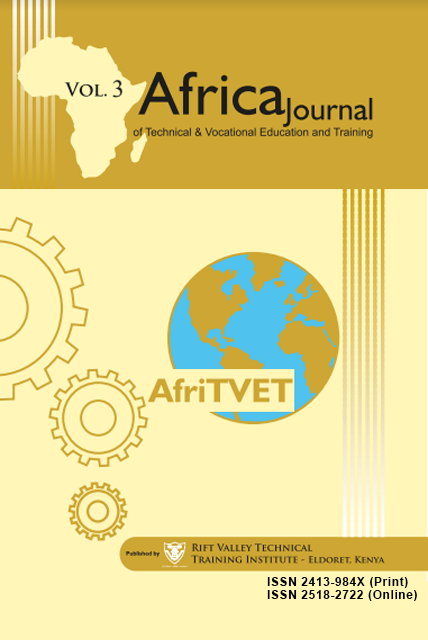An Evaluation of Student Trade Project Designs for Recyclability and Greening the Environment in TVET Institutions in the North Rift Region of Kenya
Keywords:
Recyclability, disassembly, environmental impact, waste disposal
Abstract
The study focused on an evaluation of the trade projects which trainee candidates were undertaking in TVET Institution. So far, there is limited literature available on investigations on how these student trade projects impacted on environment in TVET institutions. Due to debate on global warming and its impact on society, there is compulsion to establish whether managers of TVET really understood what this might mean for their institutions. The purpose of the study was therefore to evaluate the impact of student project designs on greening the environment in TVET institutions of North Rift Region of Kenya, and was guided by two objectives; to determine whether such projects were in compliance with public procurement and disposal act, and to examine whether projects supervisors put emphasis on projects environmental impact as required by National Environmental Management Authority (NEMA). Descriptive research design was employed, while questionnaires & observation methods were used for data collection. A sample of 102 projects that were done over a period of 5 years was selected using cluster and purposive sampling from 6 institutions in the North Rift Region of Kenya. Data was analyzed at confidence level of 95% by descriptive statics and inferential statistics. The findings indicate that student trade projects were not environmentally sensitive. Secondly, that majority of such project designs did not consider possibility of recyclability, disassembly or disposal after they were finished with them. Conclusions drawn from the research showed that most trainees’ trade projects did not consider the impact on the environmental in choosing their designs, and that the lecturers who supervised the projects did not put any emphasis on environmental sustainability – green designs & recyclability of the project materials. The recommendations were that every project done by trainees must seek to address its impact on the environment; that project supervisors should insist on the recyclability, waste disposal management and cost effectiveness of materials used; and that TVET Institutions should implement energy plan and install noise barriers and recycle most project materials to earn some income to enhance greening the institutions. It is also recommended for institutions to include student project in their audits as focal areas in their work plan activities.Article Views and Downloands Counter
Download data is not yet available.
References
Alexander, S. (2008). Green hotels: opportunities and resources for success, zero. Wastle Alliance.
Business Dictionary. (2009). www.emeraldinsight.com/doi/abs/10.1108/095041209
10935183
Laws of Kenya. (2010). Constitution of Kenya, 2010. National Council for Law Reporting. www.kenyalaw.org
Donaldson, T. P., & Lee, E. (1995). The stakeholder theory of the Corporation: Concepts, Evidence, and Implications. Academy of Management 20 (1): 71. Doi: 10.2307/258887. JSTOR 258887.
Ecotourism Kenya. (2014). Linking communities tourism and conservation. http://www.ecotourism kenya.org/page.php?id=2
Freeman, R. E., Harrison, J. S., Wicks, A. C., Parmar, B. L., & De Colle, S. (2010). Stakeholder theory, State of the Art. United States of America, New York: Cambridge University Press. www.cambridge.org.
Friedman, A. L. & Miles, S. (2002). Developing stakeholder theory. Journal of Management Studies, 39 (1): 1–21. doi:10.1111/1467-6486.00280
Gakungu, N. K., Gitau, A. N., Njoroge, B. N. K. & Kimani, M. W. (2012). Solid waste management in Kenya: A case study of public technical training institutions. ICASTOR Journal of Engineering, 5, (3). 127 – 138.
Gullen, G. (2008). Wood preservation properties of Zinc and Mn containing solution obtained by battery recycling process. http//www.tandfonline.com/doi/ full/10.1179/
International Energy Agency. (2012). Emission from fuel consumption highlights. Paris: IEA Publications.
Lyon, P. T., & Maxwell, J. W. (2008). Corporate social responsibility and the environment: A theoretical perspective. Review of Environmental Economics and Policy, 2, (2), 240-260
Majumdar, S. (2007). Integrating sustainable development in TVET curriculum. Paper presented in the 11th UNESCO – APEID International Conference on “Reinventing Higher Education: Toward Participatory and Sustainable Development” Bangkok, Thailand.
Majumdar, S. (2011). Developing a greening TVET framework. http://www.unevoc.unesco.org/fileadmin/user_upload/docs/Greening_TVET_Framework.
Nassiuma, D. K. (2000). Survey and sampling methods. Nairobi: University of Nairobi press.
NEMA.(2017). National environmental management authority regulations Nairobi.https://www .nema.go.ke/index.php?option=com content&view=article&id=135&Itemid=236.
Otieno, T. (2010). Storm clouds of our solid waste may blow us away if we don’t act now. Daily Nation Newspaper, 25 October 2010.
UNESCO-UNEVOC. (2013). Greening TVET: Qualifications needs and implementation strategies. Report of the UNESCO-UNEVOC Virtual Conference, 12 to 26 November 2013.
UNESCO. (2014). Roadmap for implementing the global action programme on education for sustainable development. Paris: UNESCO.
Business Dictionary. (2009). www.emeraldinsight.com/doi/abs/10.1108/095041209
10935183
Laws of Kenya. (2010). Constitution of Kenya, 2010. National Council for Law Reporting. www.kenyalaw.org
Donaldson, T. P., & Lee, E. (1995). The stakeholder theory of the Corporation: Concepts, Evidence, and Implications. Academy of Management 20 (1): 71. Doi: 10.2307/258887. JSTOR 258887.
Ecotourism Kenya. (2014). Linking communities tourism and conservation. http://www.ecotourism kenya.org/page.php?id=2
Freeman, R. E., Harrison, J. S., Wicks, A. C., Parmar, B. L., & De Colle, S. (2010). Stakeholder theory, State of the Art. United States of America, New York: Cambridge University Press. www.cambridge.org.
Friedman, A. L. & Miles, S. (2002). Developing stakeholder theory. Journal of Management Studies, 39 (1): 1–21. doi:10.1111/1467-6486.00280
Gakungu, N. K., Gitau, A. N., Njoroge, B. N. K. & Kimani, M. W. (2012). Solid waste management in Kenya: A case study of public technical training institutions. ICASTOR Journal of Engineering, 5, (3). 127 – 138.
Gullen, G. (2008). Wood preservation properties of Zinc and Mn containing solution obtained by battery recycling process. http//www.tandfonline.com/doi/ full/10.1179/
International Energy Agency. (2012). Emission from fuel consumption highlights. Paris: IEA Publications.
Lyon, P. T., & Maxwell, J. W. (2008). Corporate social responsibility and the environment: A theoretical perspective. Review of Environmental Economics and Policy, 2, (2), 240-260
Majumdar, S. (2007). Integrating sustainable development in TVET curriculum. Paper presented in the 11th UNESCO – APEID International Conference on “Reinventing Higher Education: Toward Participatory and Sustainable Development” Bangkok, Thailand.
Majumdar, S. (2011). Developing a greening TVET framework. http://www.unevoc.unesco.org/fileadmin/user_upload/docs/Greening_TVET_Framework.
Nassiuma, D. K. (2000). Survey and sampling methods. Nairobi: University of Nairobi press.
NEMA.(2017). National environmental management authority regulations Nairobi.https://www .nema.go.ke/index.php?option=com content&view=article&id=135&Itemid=236.
Otieno, T. (2010). Storm clouds of our solid waste may blow us away if we don’t act now. Daily Nation Newspaper, 25 October 2010.
UNESCO-UNEVOC. (2013). Greening TVET: Qualifications needs and implementation strategies. Report of the UNESCO-UNEVOC Virtual Conference, 12 to 26 November 2013.
UNESCO. (2014). Roadmap for implementing the global action programme on education for sustainable development. Paris: UNESCO.
Published
2018-06-12
How to Cite
Musyimi, T. (2018). An Evaluation of Student Trade Project Designs for Recyclability and Greening the Environment in TVET Institutions in the North Rift Region of Kenya. Africa Journal of Technical and Vocational Education and Training, 3(1), 23-33. Retrieved from https://afritvet.org/index.php/Afritvet/article/view/57
Section
GREENING TVET: BEST PRACTICES AND CASE STUDIES
Copyright Notice
Copyright of published articles is held by AfriTVET. No limitation will be placed on the personal freedom of authors to copy or to use in subsequent work, material contained in their papers. Please contact the Publisher for clarification if you are unsure of the use of copyright material. Apart from fair dealing for the purposes of research and private study, or criticism and or review, this publication may only be reproduced, stored or transmitted, in any form or by any means, with the prior permission in writing of the Publishers.



